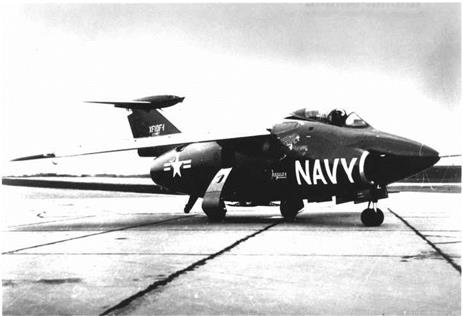Grumman XF10F Jaguar
The variable-sweep XF10F Jaguar was Grumman’s attempt to avoid fully powered pitch controls during the jet’s awkward age. The Jaguar’s horizontal tail was on a large streamlined pod that pivoted in pitch on top of the vertical tail (Figure 7.3). This pivoted assembly was in effect a separate canard airplane, trimmed in pitch by a direct connection between the pilot’s stick and the canard.
The trim lift coefficient attained by the pivoted canard tail assembly was of course the tail lift coefficient for the XF10F as a whole. This ingenious system amounted to a tab control system, since the canard control surface attached to the pilot’s stick was a relatively small surface with low hinge moments. Yet the tail loads for the XF10F’s stability and control were provided by an all-moving surface that was not subject to control surface effectiveness losses and unpredictable hinge moments at transonic Mach numbers.
In Navy flight tests, the XF10F ran out of nose-up longitudinal control for landing at some loadings, due to insufficient down deflection of the canard. Another serious problem with the canard airplane horizontal tail was a low natural frequency at low airspeeds. This produced a large time lag between pilot stick motion, tail, then airplane, response. Pilots complained that at low airspeeds they had no idea of the tail’s incidence angle.
The Navy canceled production plans for the variable-sweep XF10F in 1953. The airplane never received the engine it was supposed to have, leaving it with poor performance. Also, the advent of slanted deck carriers and steam catapults allowed fixed-sweep airplanes to be
|
Figure 7.3 The Grumman XF10F-1 Jaguar, an attempt to avoid powered pitch controls. A freely pivoted canard-controlled body and wing is mounted on top of the vertical tail. The pilot’s stick moves the canard, which controls the angle of attack of the pivoted body. (From National Air and Space Museum) |
operated from carriers. The XF10F’s ingenious canard airplane horizontal tail design has not been used on later airplanes.














